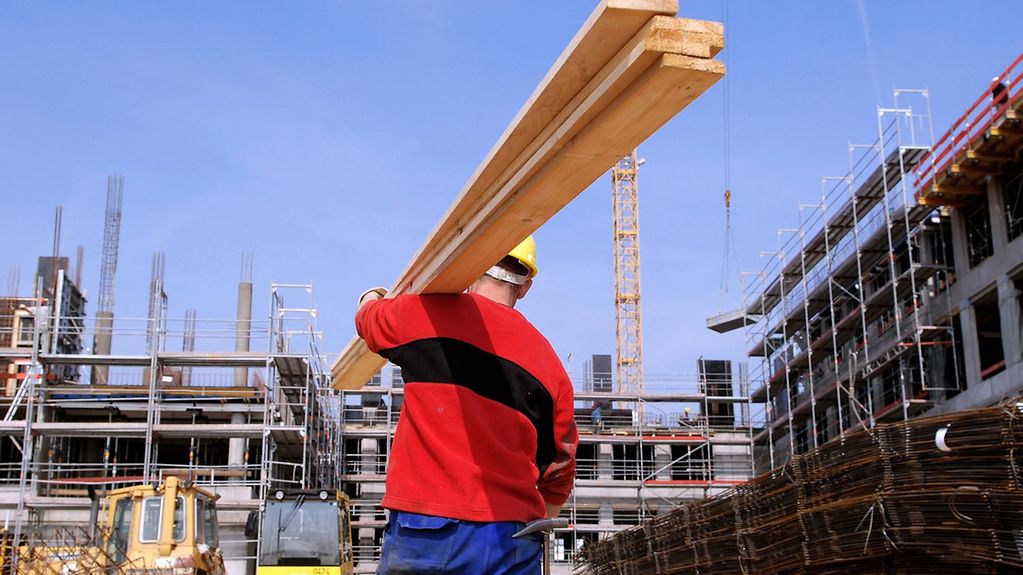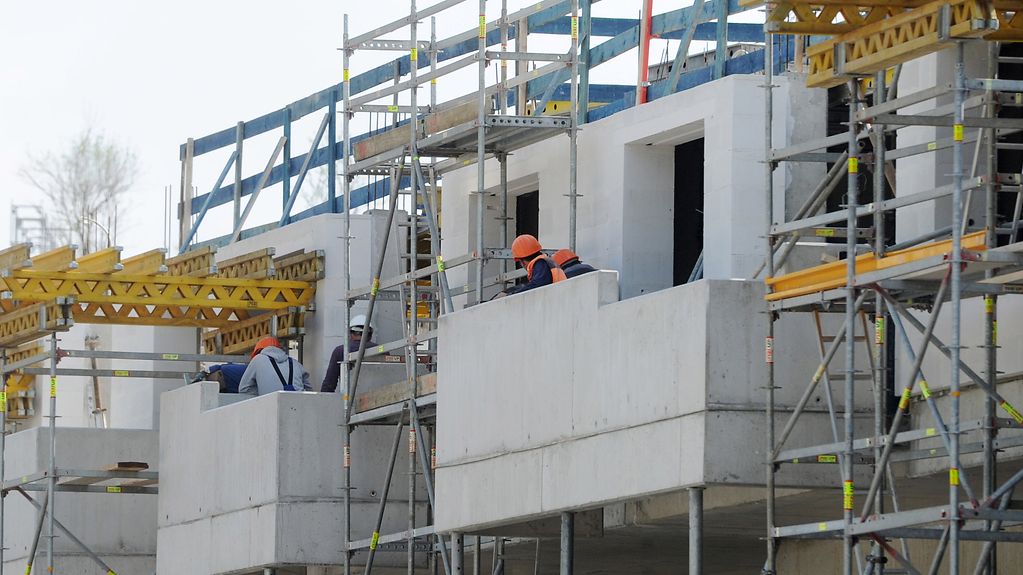Affordable building and housing
In the current legislative period the Federal Government has set the conditions for the construction of new housing and to ensure that rental prices remain affordable. Housing has become a relevant social welfare issue in Germany’s large urban centres. All the key resolutions adopted at the Housing Summit in September 2018 have since been implemented or got underway. The Federal Government provides several billion euros in funding to social housing construction and urban development. It sells building land to local authorities, sometimes at zero cost. The brake on rental costs (Mietpreisbremse) was adjusted and the housing allowance increased. Here is an overview of the overall package of measures.
9 min reading time

The Federal Government aims to step up housing construction and to ensure that housing remains affordable
Photo: Arne Dedert/picture alliance/dpa
Facts about the housing market
Developments on Germany’s housing markets vary greatly from region to region. Population growth in major urban centres, big cities and university towns is also leading to increased demand for housing. Residential accommodation is often in short supply there, and rents and real estate prices are often much higher than in more rural regions.
After years of considerable increases in rents quoted, current figures show that since 2019, and especially in the second half of 2020, there was a clear slow-down in average rent increases across Germany.
For example, rents for advertised residential accommodation – both for new rentals and existing tenants – rose by only 3.1 per cent in 2020. The price rise dropped by 1 percentage point year on year.
Rents under existing rental contracts for existing tenants have risen considerably less in recent years. According to the consumer price index, net rents exclusive of heating (which primarily refer to existing contracts) have risen by only 1.4 per cent on average in the past four years.
The housing costs quota – that is the share of housing costs (incl. water and wastewater, energy and heating costs, and maintenance costs for apartments and houses) of disposable household income – has dropped significantly in recent years, and stood at 25.9 per cent in 2019. The share of the population living in households which spend more than 40 per cent of their disposable income on housing has also been falling for years. In 2019 it stood at 13.9 per cent, that is two percentage points lower than in 2016.
Construction activity has increased significantly – including in big cities – since the lowest number of completed buildings was registered in 2009. In 2019 a total of 293,000 homes were completed – more than 80 per cent more than 10 years ago. In 2020, an estimated 300,000 dwellings were completed, more than ever in the past 20 years. More new homes are in particular being created on account of the construction of multi-occupancy dwellings (59 per cent of new housing construction). The backlog of 770,000 approved homes (as at: February 2021) leads one to expect that this positive trend in buildings being completed will continue.
The shortage of building land in many metropolitan regions is leading to a rise in prices: prices for building land rose by 84 per cent across Germany between 2010 and 2019. Comparing 2019 with 2018, prices for newly completed residential properties and building land were seen to be on a downward trend. In 2019, prices rose less steeply than in previous years. Building prices have also been rising at a moderate pace since early 2019 on account of growing capacities in the construction sector.
The demand for new housing, which has been growing for years, can only be gradually met. Additional capacities in the building industry and swifter processes, for example on account of using serial construction methods, help to speed up progress in this area.

Building new housing – the Federal Government has also reformed the housing allowance
Photo: picture alliance / dpa
What we have achieved
Implementation of measures under the Housing Strategy has been extremely successful. All the key resolutions adopted at the Housing Summit in September 2018 have either been implemented or have got underway.
…to step up housing construction
- The Federal Government is making a total of 5 billion euros available in the period 2018 to 2021 to promote the social housing sector. That, together with funding provided by the federal states and local authorities, means that more than 100,000 social homes can be built. It will help to increase the number of dwellings on offer and ensure that rental prices remain affordable.
- Since the reform of Germany’s federal system in 2006, the federal states alone have been responsible for promoting the social housing sector. Thanks to the 2019 amendment to the Basic Law, as of 2020 the Federal Government has been able to earmark financial assistance for social housing construction on a long-term basis. In the period up until 2024 it will be making 1 billion euros available annually.
- The Federal Government’s Baukindergeld programme helps families with children to build or buy their own homes. It has made a total of some 9.9 billion euros available to the allowance. New builds with building permission or purchase agreements signed between 1 January 2018 and 31 March 2021 (extended due to the coronavirus pandemic) are eligible. Since September 2018 a total of 310,000 families with children have applied for the allowance, including numerous families on low incomes.
- As regards the home ownership savings premium (Wohnungsbauprämie), income thresholds and the premium itself were increased as of 2021.
- In August 2021 a new special depreciation allowance was introduced for new rented housing construction. An additional 5 per cent of the purchase and 5 per cent of the construction costs of new rented housing are tax deductible for investors over a four-year period. The possibility of deducting 2 per cent annually remains in place.
- There are also tax benefits for reduced-rate staff rental accommodation.
- The Federal Government is promoting urban development at a consistently high level. In 2020 – as in 2019 – it made some 790 million euros available. The Federal Government and federal states have agreed that the focus of urban development is to be on town and city centres and that greater use is to be made of vacant land in municipalities.
- The Institute for Federal Real Estate (BImA) contributes to the reduced-price sale of plots of land to municipalities and local housing associations for the construction of social housing. Over the next few years BImA will also be building up to 8,000 homes for federal employees using the serial and modular method.
- The Federal Government has updated its Award and Contract Procedure for Construction Services (VOB/A) to ensure that public building contracts are awarded more flexibly and more quickly.
- To speed up building, the building ministers of the 16 federal states in February 2019 adopted a rule to incorporate type approvals into their building regulations. Type approvals can speed up procedures for granting planning permission because clients no longer have to apply for a permit for each individual house. It is enough for permission to be obtained for one type of house or apartment.
- The Federal Government already revised building law in the course of the last legislative period, and in 2017 it introduced the new category of land use area called “urban region”. As a result, residential accommodation can also be built in very dense urban regions or in industrial estates and buildings in those areas can be turned into residential accommodation. It also increases the amount of available housing whilst at the same time using less land.
- The federal states and municipalities are consistently pushing ahead with the digitalisation of planning law and construction supervision procedures. The foundations have been laid for an online application so as to make it faster and cheaper to issue building permits. The Federal Government and federal states have developed a concept for limiting follow-on costs for the setting of norms and standards in the housing construction sector.
- Based on recommendations made by the Building Land Commission, the Federal Cabinet on 4 November 2020 adopted the Draft of an Act to Release Available Building Land (Gesetzentwurf zur Mobilisierung von Bauland). Its aim is to make it easier for communities to use and release additional land for housing construction purposes, including for social housing construction, for example. Tenants are to be better protected against existing rental accommodation being turned into owner-occupied housing.
…to ensure that rental prices remain affordable
- The Federal Government has reformed the housing allowance. As of 1 January 2020 more people are entitled to claim housing allowance, and the amount payable has been increased. The maximum rents are graduated in line with regional differences. As of 2022 the housing allowance will be adjusted every two years to current rental and income trends. That will mean, for example, that older people in particular will be able to remain in familiar surroundings. To avoid social hardship, those receiving the housing allowance have since January 2021 also had to pay less towards their heating costs. Since then, harmful CO2 emissions arising from heat production using fossil fuels such as fuel oil and gas have been payable.
- The improved and extended brake on rental costs (Mietpreisbremse) has enhanced tenants’ rights. The brake on rental costs was introduced in 2015, and an evaluation conducted in 2019 on behalf of the Federal Ministry of Justice and Consumer Protection showed that it has led to a moderate slowing of rent increases in those federal states which are applying it.
The Rental Law Adaptation Act (Mietrechtsanpassungsgesetz), which entered into force in early 2019, means the Federal Government was able to make further improvements to the brake on rental costs:
- Before concluding a rental contract, landlords are now required to provide tenants with information about exemptions to the brake on rental costs and about the amount of rent paid by the previous tenant.
- In the event of violations against the brake on rental costs, tenants are entitled to claim back the entire amount of excess rent paid. To be eligible, they need to claim a violation within 30 months after the start of the rental agreement under a simplified procedure. Otherwise, they are only entitled to repayment of the amount of rent paid unlawfully following receipt of the objection.
- Only 8 per cent, not 11 per cent as was previously the case, of modernisation costs can now be passed on to tenants in the form of an increase in rental costs. There is a cap on the permissible amount. Tenants are thus better protected against attempts made by landlords to exploit provisions relating to the modernisation of rental accommodation.
In addition, the brake on rental costs was extended by five years – until 2025. - More legal certainty regarding rent level surveys (Mietspiegel): Rent level surveys are the most important instrument for calculating local reference rents. Landlords can use rent level surveys to justify rent increases, for instance, which is why they need to realistically depict the housing market. To create more legal certainty in this regard, the Federal Cabinet in December 2020 agreed on minimum requirements to be applied when drawing up qualified rent level surveys. To improve the data basis a duty of disclosure was also introduced for tenants and landlords. Rent level surveys are in future to be updated every three years, rather than every two years as in the past; qualified rent level surveys are to be updated every five years.
- In January 2020 the review period for local reference rents was increased to six years, from previously four years. This also helps to slow the rate of rent increases.
- Back in 2015 the principle of “whoever orders, pays” was introduced into estate agent law in relation to rental accommodation. As of 23 December 2020, those buying and selling apartments and detached homes have to share the estate agent’s fees.